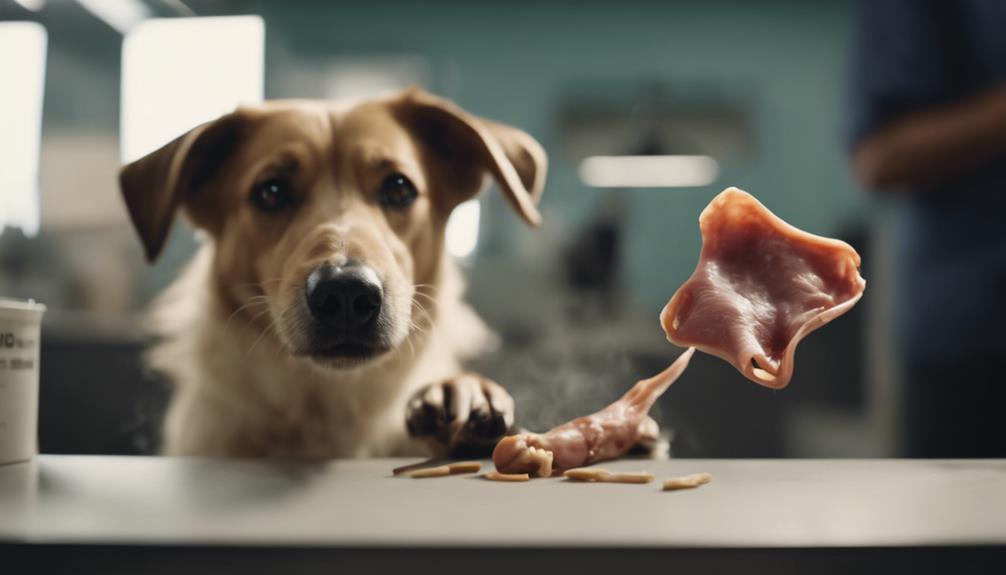When it comes to selecting suitable treats for our canine companions, the question of whether pig ears are a beneficial choice often arises.
The debate surrounding the consumption of pig ears by dogs is multifaceted, as it involves considerations of both health benefits and potential risks. While these crunchy treats offer a satisfying chewing experience and can contribute to oral hygiene, there are important safety precautions and feeding guidelines to be aware of.
Understanding the nuances of pig ear consumption for dogs is essential for pet owners looking to make informed decisions about their furry friend's dietary options, ensuring their well-being remains a top priority.
Key Takeaways
- Pig ears are a great source of enrichment and dental health for dogs.
- Feeding guidelines should align with dogs' caloric needs to prevent weight gain.
- Caution is advised for small breed dogs due to potential gastrointestinal issues.
- Not recommended for puppies under six months due to their vulnerable immune systems.
Pig Ears Composition and Benefits
Pig ears, composed of pig skin, cartilage, and muscle, offer numerous benefits for dogs' enrichment and dental health. These natural chews provide mental stimulation, preventing boredom and destructive behaviors in dogs. The tough texture of pig ears helps promote healthy teeth and gums by reducing plaque and tartar buildup.
Additionally, dogs find pig ears delicious, making them an enjoyable treat that can keep them entertained for extended periods. Their composition also ensures that dogs get a satisfying chewing experience, which is essential for their overall dental hygiene and well-being. When given in moderation and under supervision, pig ears can be a valuable addition to a dog's diet, supporting both physical and mental health.
Feeding Guidelines and Safety Measures
When considering the appropriate consumption of pig ears for dogs, it is essential to adhere to specific feeding guidelines and safety measures to ensure the well-being of your canine companion. Pig ears are likened to ice cream for humans by veterinarians, safe for medium- and large-sized dogs as an occasional treat.
Due to their high fat and calorie content, pig ears should be fed sparingly, with considerations for smaller dogs involving portion control through cutting. It is crucial to align feeding guidelines with the caloric needs of dogs to prevent weight gain.
Caution is advised for small breed dogs due to potential gastrointestinal issues, and awareness of recalls and proper hygiene when handling pig ears is paramount for overall safety and health.
Potential Risks and Precautions

Understanding the potential risks and necessary precautions associated with feeding pig ears to dogs is crucial for responsible pet ownership and canine well-being. When offering pig ears to your furry friend, consider the following:
- Risk of gastrointestinal issues in small breed dogs
- Not recommended for dogs on low-fat or sensitive GI diets
- Potential problems such as vomiting, gas, and diarrhea
- Serious complications like pancreatitis may arise in some dogs
Ensuring you are aware of these risks and taking appropriate precautions can help keep your canine companion safe and healthy when enjoying pig ears as a treat. Regular monitoring and consulting with a veterinarian can also aid in preventing any adverse reactions or health issues.
Dealing With Emergency Situations
In the event of an emergency involving a dog and a pig ear treat, swift and appropriate action is essential to ensure the well-being of the canine companion.
If a dog swallows a pig ear whole and can breathe, no immediate emergency action is necessary. However, if the dog chokes on a pig ear, prompt first aid and veterinary attention are crucial.
Signs of esophageal obstruction, breathing difficulties, or gastrointestinal upset require immediate veterinary intervention. Monitoring for symptoms such as refusal to eat, vomiting, or diarrhea is vital.
It is important to consult a veterinarian promptly if any concerning signs or behaviors develop after the ingestion of a pig ear treat to address potential complications effectively.
Considerations for Puppies

For young puppies, careful consideration is essential when introducing pig ears as a treat due to their vulnerable immune systems and sensitivity to potential gastrointestinal issues. Puppies under six months of age may not be the best candidates for pig ears due to the following considerations:
- Higher susceptibility to treat contamination.
- Increased risk of gastrointestinal upset.
- Potential for digestive disturbances.
- Consultation with a veterinarian before offering pig ears is recommended.
Conclusion
In conclusion, pig ears can be a beneficial treat option for dogs, providing both enrichment and oral health benefits.
However, it is essential for pet owners to follow proper feeding guidelines, monitor for potential risks, and be prepared to handle emergency situations.
By understanding the composition, benefits, and precautions associated with pig ear consumption, pet owners can make informed decisions to ensure the well-being of their canine companions.




